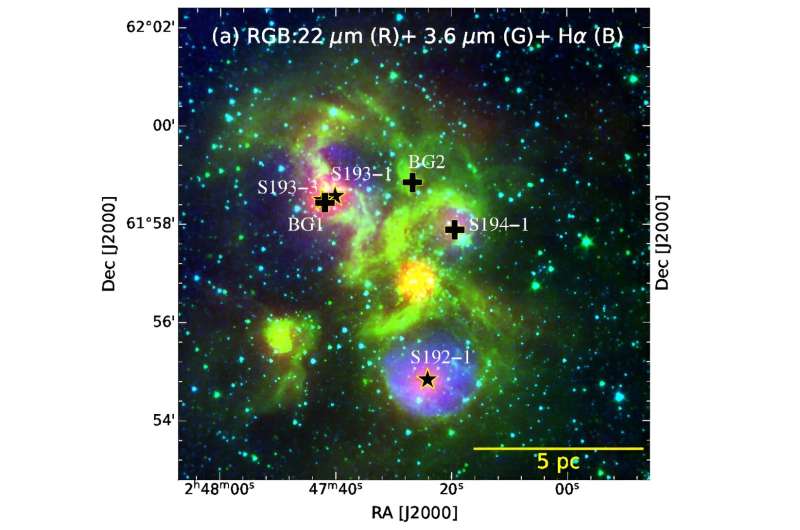October 5, 2023 report
This article has been reviewed according to Science X's editorial process and policies. Editors have highlighted the following attributes while ensuring the content's credibility:
fact-checked
preprint
trusted source
proofread
Indian astronomers investigate star-forming complex S193

Astronomers from the Physical Research Laboratory in Ahmedabad, India and elsewhere, have inspected a star-forming complex known as S193, using multiwavelength observational data. Results of the study, published Sept. 21 on the pre-print server arXiv, shed more light on the properties of this complex.
Located some 17,000 light years away from the Earth, between star-forming regions W4 and W5, S193 is a star-forming complex consisting of three HII (ionized atomic hydrogen) regions, namely: Sh 2-192 (or S192), Sh 2-193 (S193) and Sh 2-194 (S194). The complex also hosts two open clusters (designated [BDS2003]57 and Teutsch 162), 10 molecular clumps and many massive stars.
Therefore, S193 is an excellent place to investigate the star formation processes involving massive stars, young star clusters, and molecular clumps. That is why a team of astronomers led by Rakesh Pandey decided to take a closer look at this complex. They examined the observational data from various ground based facilities, including the Himalayan Chandra Telescope (HCT), and also from space observatories, in order to get more insights into the properties of S193.
"We have studied a star-forming complex S193 using near-infrared (NIR) observations and other archival data covering optical to radio wavelengths," the researchers wrote in the paper.
The team detected a new cluster in S193 in the south-west direction, which contains at least 30 stars. The cluster has a mean stellar density at a level of of 13.3 stars/arcmin2. It was noted that all the three clusters in S193 appear to be connected through the lowest density contours and their stars seem to be part of a similar population.
The study also identified 27 young stellar objects (YSOs) in S193, distributed mostly towards [BDS2003]57, and 16 molecular clumps. The most massive clump (with a mass of approximately 1,142 solar masses), which is also relatively cold, is seen towards [BDS2003]57, accompanying several YSOs.
Using the mid-infrared and far-infrared images, the astronomers traced the distribution of dust in S193. They found that dust is distributed in arc-type structures around the HII regions. Furthermore, photo-dissociation regions have been also traced around the HII regions, suggesting the significant heating of the massive stars in the complex.
Based on the proper motions data, Pandey's team estimate that S193 is located about 15,800 light years away, thus at a closer distance than previously thought. They also found that the spectral type of the ionizing sources for all the HII regions in S193 is between B0.5–B0 type.
Trying to find the cause of the formation of a new generation of stars in S193, the authors of the paper assume that the feedback from the massive stars is the most plausible explanation. Furthermore, they suppose that massive stars could have played a role in the formation of [BDS2003]57, although a detailed spectroscopic and age analysis is needed in order to confirm this.
More information: Rakesh Pandey et al, Dissecting the morphology of star forming complex S193, arXiv (2023). DOI: 10.48550/arxiv.2309.12410
Journal information: arXiv
© 2023 Science X Network


















